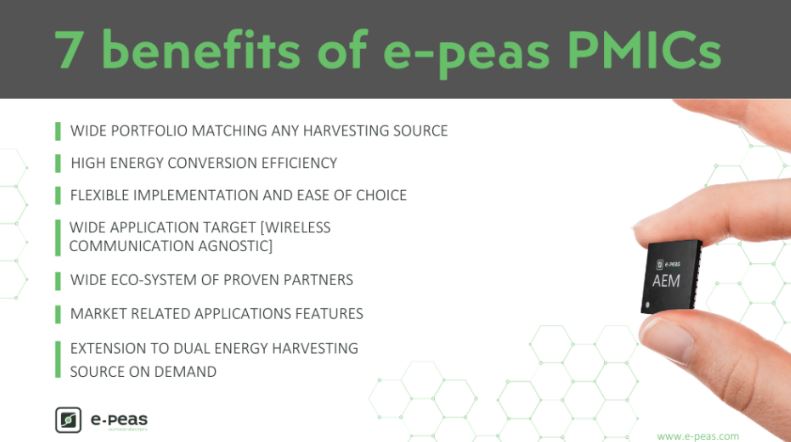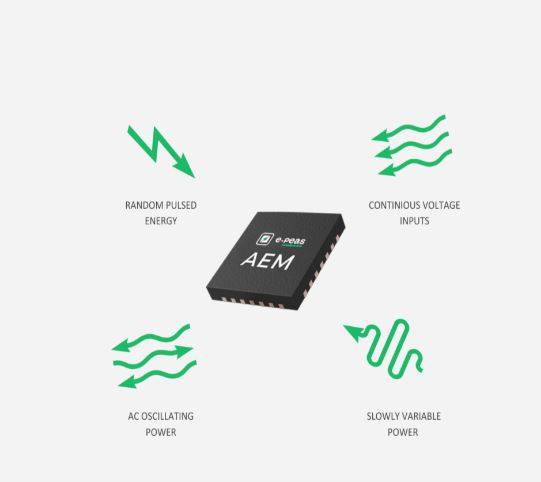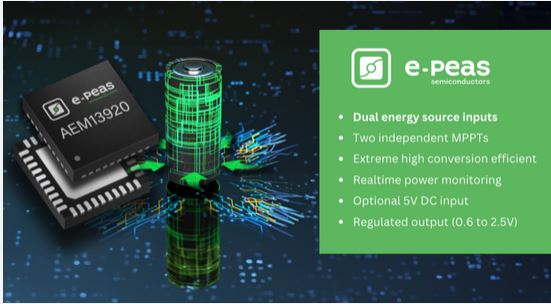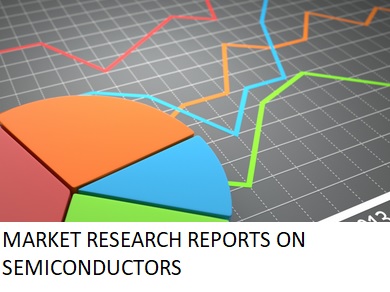Date: 22/12/2023
Unlocking 7 Benefits of Choosing e-peas’ PMICs over Competition

Choosing the right Power Management Integrated Circuit (PMIC) can be a complex task due to the diverse range of energy harvesting sources and storage elements available, each with its unique behavior and requirements. Moreover, different applications demand a variety of supply voltage and power, ranging from low-power devices like BLE beacons to robust and powerful asset trackers embedded in cargo ships having GPS and cellular technology embedded. The compatibility of the PMIC with the chosen energy source, storage element, and connectivity chipset must be meticulously considered to ensure seamless operation. Additionally, factors like shape, color, weight, and size of the energy supply source (including the PMIC) play a significant role in successful deployment of an OEM solution, while also influencing the performance of the overall product.
At e-peas, they not only provide a dedicated Support team to assist you in transitioning to Energy Harvesting, but they also offer a unique set of PMICs which have performances and competitive advantages unparalleled in the market.
Let’s delve into them:
1.Setting us apart from other companies, e-peas boasts an extensive portfolio of diverse PMICs (15 in total) tailored to a wide range of energy sources.
Why does this matter?
A) Because each energy harvesting source has its own behavior and requires a tailored power management.
Every energy source type (light/RF/vibration/thermal, etc.) may be continuous, pulsed, or slowly changing. Such breadth of behavior can only be encompassed with specialized PMICs with which you can reach superior performance in energy conversion. E-peas’ PMICs deliver superior efficiency and support all significant energy sources behaviors:
Random pulsed energy
Continuous voltage inputs
AC oscillating power
Slowly variable power with high dynamic output impedance.
B) Because the storage element that is buffering energy from the multiple sources also has its own ‘way of life’ which can be easily addressed by our programmable PMICs:
Baseline is that Safe-Operating-Area of the storage element must be guaranteed not to be over-passed to prevent early failure or performance degradations. We must consider at least four major technologies of storage elements to be deployed in the field:
NiMH
Lithium Ion (including many variants)
Super capacitors
Hybrid capacitors
Each storage element has its own behavior and pros and cons that will influence developers’ preferences. E-peas PMICs’ programmable interface allows developers to bundle a storage element with an energy source in a system, to achieve optimized performance and reliability of the system. Our dynamic Selector Guide allows you to select PMICs as per storage voltage to enable the LOAD and storage element protection.
In case you do not find the one you prefer, our “custom mode” configuration helps you to get there.
2. Another advantage offered by e-peas is support of multiple connectivity protocols. This allows it to fit the requirements of so many markets. It is important because one can not address existing and emerging applications with a single MCU and RF interface.
A Consumer Sensor running Matter protocol over Thread or LORAWAN stack, a Remote Control Units (RCU) running BLE Audio, an Asset Tracker running RTLS stack or GPS + cellular connectivity, a Personal Computer Keyboard running Proprietary protocols are using so many different hardware platforms with so multiple mission profiles and power consumptions. They have their own power plane/hardware architecture to which the energy source must adapt.
The versatile portfolio of e-peas has this capability to adapt built-in. Even the most recent cellular chipsets running NBIoT in various countries are supported. We have made reference designs for that.
The breadth of connectivity chipsets supported by e-peas PMICs are covering WAN LPWAN, WLAN, PAN. To name a few:
3. When delving into energy generation, the choice of PMIC holds paramount importance. Optimal energy conversion efficiency is pivotal for various facets including:
Design integrity
Quality of Service
Implementation costs
Reliability
and overall electronic performance.
With e-peas PMICs, energy efficiency is more than optimal, often surpassing an impressive 90% conversion efficiency mark from source-to-storage. This attribute has garnered high regard among developers, reinforcing their preference for e-peas solutions.
4. A significant advantage of e-peas based solutions is that we have an extended eco-system of proven partners for completion of an overall energy harvesting design.
Depending on your product requirements, application constraints, and regulatory environment, you will usually need to select two additional elements to complete the design based on our PMICs: a storage element and an energy harvesting source.
Many developers are already familiar with conventional storage element technology commonly used in devices not employing energy harvesting, such as rechargeable batteries like Lithium Fe PO4 and Lithium Polymer found in most devices. However, there are numerous other options with distinct advantages worth exploring. The e-peas ecosystem offers a wide range of such alternatives.
Energy Harvesting sources may be perceived as a novel concept for many, due to their innovative nature. That’s why at e-peas we take extra care to provide our customers with the best expertise in the ecosystem of additional elements required for energy harvesting design. Here are just some examples of the wide variety of energy sources and technologies which developers can pick from, influencing energy harvesting PMIC design:
– Single or multiple element photovoltaic sources
– Amorphous PV technology
– Poly crystalline PV technology
– DSSC PV technology
– Perovskite PV technology
– Organic PV technology
– Thermo electric generators
– Kinetic switch generators
– RF source harvester
– etc.
The choice of energy harvesting sources from our partners is wide and varies in technology, form factors, and performances. Our support team will assist you in choosing the right components to perfectly match our PMICs for the best performance of the overall design.
Our ecosystem will allow you to choose companies and technologies which have been tried and tested with our PMICs for the best performance. This will make the process of shift smooth and efficient. Reach out to us to get access and advice on how to use this network: www.e-peas.com/contact
5. One more benefit which e-peas offers to developers is flexibility of implementation and ease of choice. It is important because actual working solutions happen if one is free to select the best combination of storage element and energy harvesting source for his own particular use case. Shape, color, weight, and electrical merit factor play a great deal in OEM solution deployment and success.
Finding the right energy solution ecosystem and combination is made easy both with e-peas products portfolio sheet and the dynamic selector guide available online just in one click: https://e-peas.com/aem-selector-guide.
6. Some applications require dedicated features
It’s no coincidence that one of our mottos is ‘Harvest more, consume less’. However some markets need a bit more, like application specific functions for use during the product lifetime. Tiny details make the difference when implementation time has come:
For example, a keyboard or a remote control unit would greatly benefit from real-time energy monitoring facilitated by our APM function, available on AEM00900/1 and AEM13920. This allows the application to give an alert to the user for getting a better exposure of the product to the Harvested energy source . Another interesting one is the “ship-mode” that disables storage from charging and discharging during shipping which reduces complex logistics pain. Some other valuable features e-peas offers are a five volts boost charger input and temperature monitoring and there are many more features we offer for even more complex needs.
7. What if you want to harvest energy from two energy sources?
Until recently, it was not possible to collect energy from two totally independent energy sources with one single PMIC. But e-peas has developed the first PMIC on the market that can harvest energy from two different sources. Meet AEM13920 – a dual energy source input PMIC capable of monitoring full independent energy sources with:
high energy conversion efficiency
optional 5V DC boost input
and ultra-low cold-start energy (275 mV/1.5 µW from input) .
Average Power Monitoring function offers monitoring of energy produced by each source to the storage element and from the storage element to an application. A complete energy budget analysis can be done in real time during application run time.
Source:e-peas
Tweet Follow @ecewire

